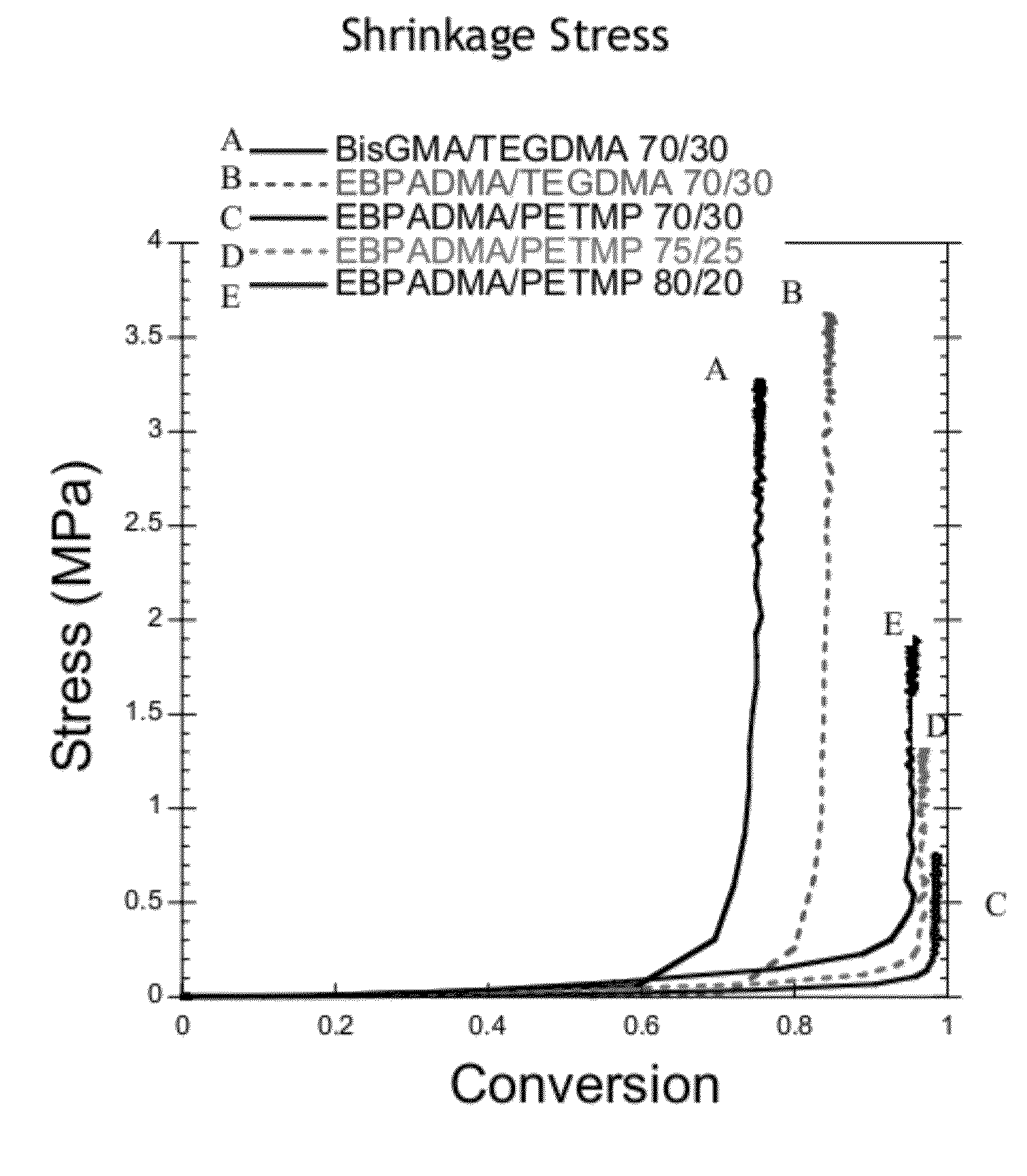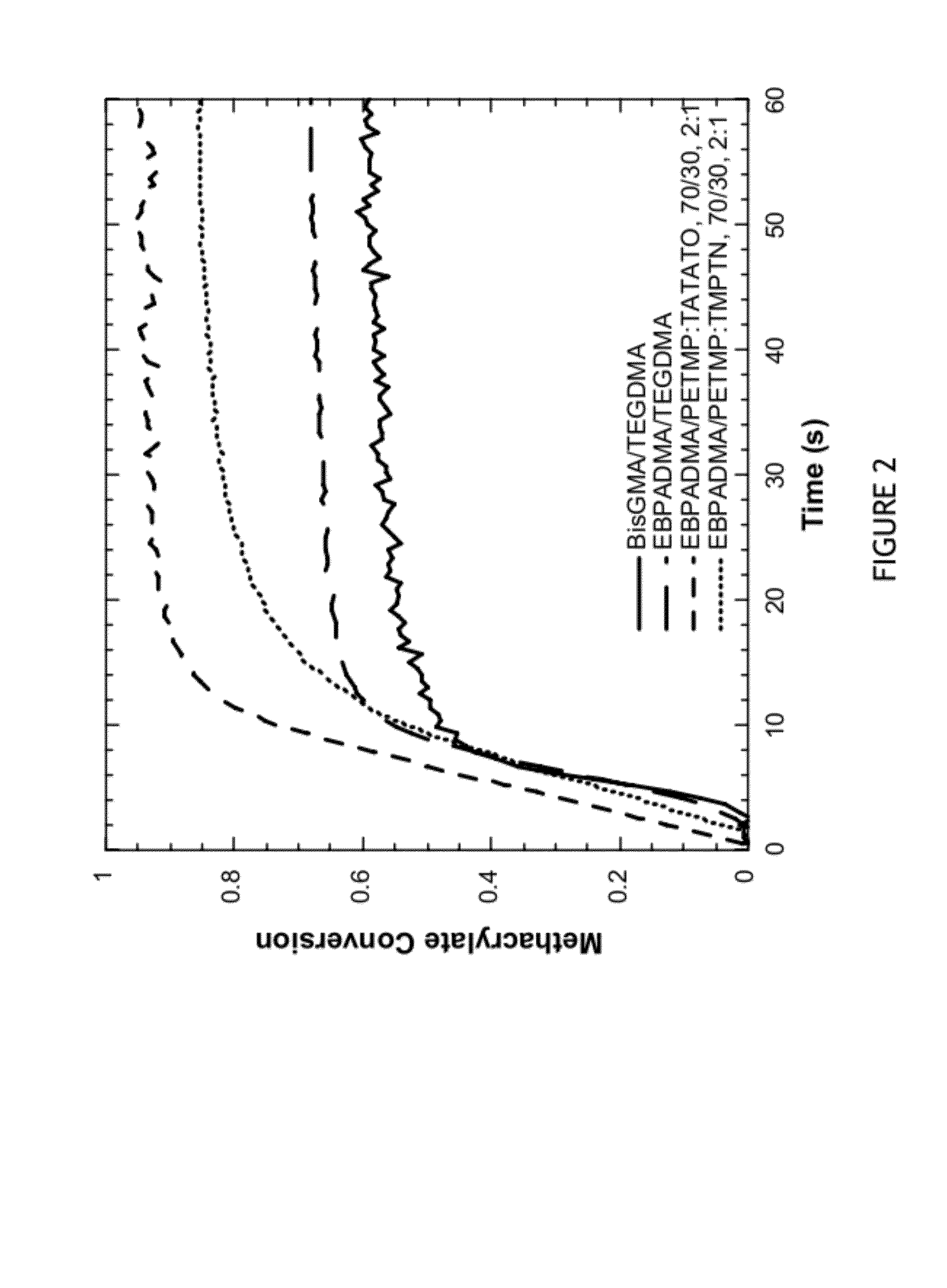Resin systems for dental restorative materials
a resin system and dental restorative technology, applied in dentistry, prosthesis, electrography/magnetography, etc., can solve the problems of long chain, insufficient wear resistance and mechanical properties, and jeopardize the biocompatibility of composite materials
- Summary
- Abstract
- Description
- Claims
- Application Information
AI Technical Summary
Benefits of technology
Problems solved by technology
Method used
Image
Examples
example 1
Polymerization Kinetics & Conversion
[0094]Polymerization kinetics were monitored for various methacrylate-thiol-ene, methacrylate-thiol and dimethacrylate control resins under identical curing conditions. All samples contained 0.3 wt % Irgacure 819, 0.035 wt % Q1301, and were irradiated at 29 mW / cm2 with a 400-500 nm filter. Conversion of functional groups was monitored by FTIR.
[0095]Functional group conversion data over time in various systems are illustrated in FIGS. 2-4. Final conversion for each system is shown in Table 1. FIG. 2 shows methacrylate conversion monitored over time for four resin systems. Two methacrylate control systems BisGMA / TEGDMA and EBPADMA / TEGMA, both at a 70 / 30 wt ratio, were compared to two methacrylate-thiol-ene systems: EBPADMA / PETMP:TATATO at 70 wt % methacrylate / 30 wt % thiol-ene with a 2:1 stoichiometric ratio of thiol to ene functional groups and EBPADMA / PETMP:TMPTN at 70 / 30 wt ratio with a 2:1 stoichiometric ratio of thiol to ene functional groups. ...
example 2
Flexural Modulus and Strength
[0100]Methacrylate conversion and mechanical properties of cured resins were tested for methacrylate-thiol-ene, methacrylate-thiol resin systems and dimethacrylate control resins when subjected to identical curing conditions. Relative monomer amounts are shown in Table 2 for each sample. All samples contained 0.3 wt % Irgacure 819, 0.035 wt % Q1301, and were irradiated at 29 mW / cm2 with a 400-500 nm filter for 150 seconds.
[0101]Results for flexural modulus and strength for methacrylate, methacrylate-thiol, and methacrylate-thiol-ene systems are shown in Table 2. The EBPADMA / PETMP 80 / 20 system exhibited an equivalent flexural modulus to BisGMA / TEGDMA and a slightly increased flexural modulus relative to EBPADMA / TEGDMA. The flexural strength is slightly reduced relative to both control systems. Increasing the PETMP content to 25 percent resulted in a decrease in both flexural modulus and strength. The EBPADMA / PETMP:TATATO system with a 1:1 thiol:ene stoich...
example 3
Shrinkage Stress
[0105]Various resin system samples were subjected to identical curing conditions with a 400-500 nm filter and 29 mW / cm measured by radiometer through 6 mm glass rods. Shrinkage stress of cured resins was measured for methacrylate-thiol-ene, methacrylate / thiol and dimethacrylate control resins when subjected to identical curing conditions.
[0106]Results for shrinkage stress and methacrylate conversion are shown in Table 4. The irradiation intensity for shrinkage stress is measured through the tip of 6 mm glass rods. As such, the actual irradiation intensity is greater than the measured intensity and the samples achieve higher conversion than for flexural or kinetic measurements. The EBPADMA / PETMP systems both exhibited reduced shrinkage stress relative to the control resins with stress decreasing with increased thiol content. The EBPADMA / PETMP:TATATO 70 / 30 systems all exhibit reduced shrinkage stress as compared to the control resins. As the thiol to ene functional gro...
PUM
| Property | Measurement | Unit |
|---|---|---|
| size | aaaaa | aaaaa |
| light wavelength range | aaaaa | aaaaa |
| light wavelength range | aaaaa | aaaaa |
Abstract
Description
Claims
Application Information
 Login to View More
Login to View More - R&D
- Intellectual Property
- Life Sciences
- Materials
- Tech Scout
- Unparalleled Data Quality
- Higher Quality Content
- 60% Fewer Hallucinations
Browse by: Latest US Patents, China's latest patents, Technical Efficacy Thesaurus, Application Domain, Technology Topic, Popular Technical Reports.
© 2025 PatSnap. All rights reserved.Legal|Privacy policy|Modern Slavery Act Transparency Statement|Sitemap|About US| Contact US: help@patsnap.com



